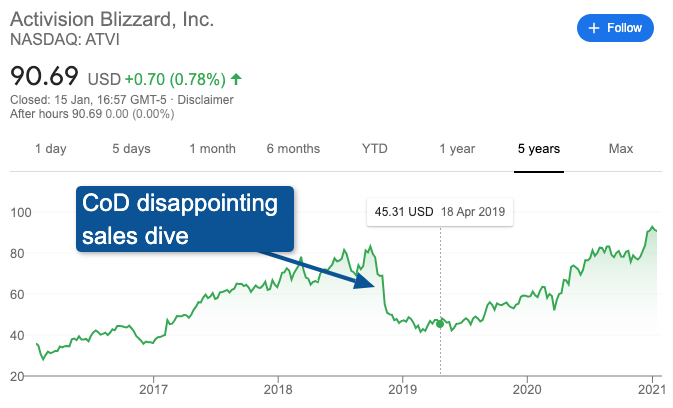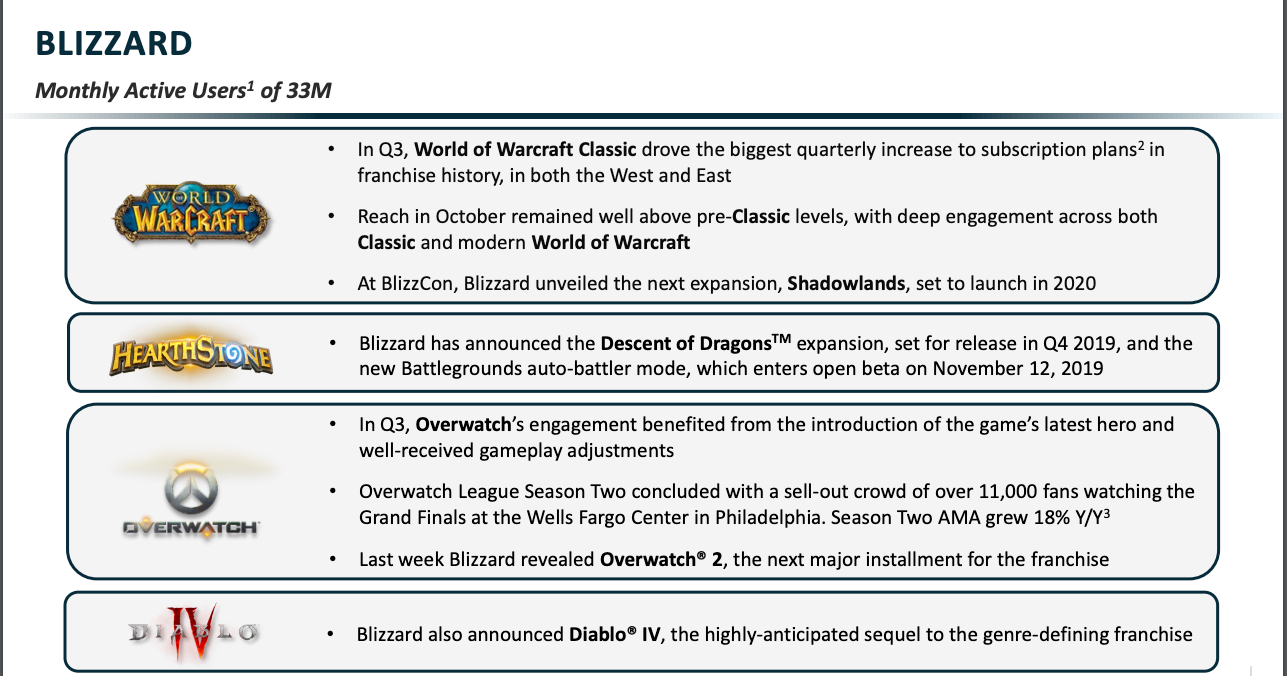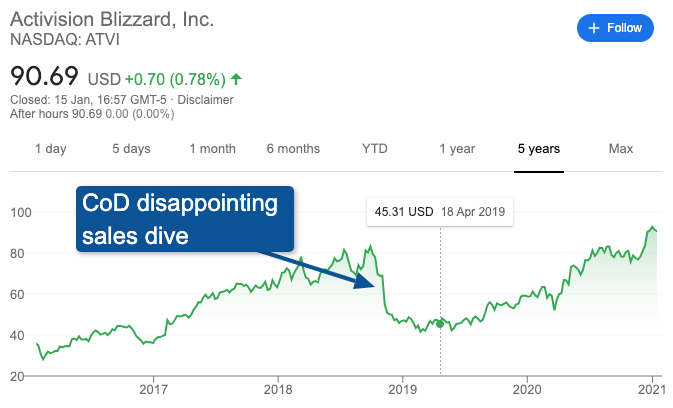Activision Blizzard is a leading gaming company, producing games for years and owning some of the industry's strongest franchises.
In recent years they have only been trend-followers in most gaming genres and business models (Call of Duty:Warzone following Fortnite, Heroes of the Storm following League of Legend, and more).
Regardless, their ability to produce quality games in each field positions them as the most diverse gaming company out there in terms of game genres and game business models.
This diversification might be the most interesting thing about the company from an investor's perspective.
Business overview
Activision-Blizzard is divided into three big segments: Activision, Blizzard, and King.
This division is historical - each used to be its own company, now owned by the same entity. The division in brands is strict so far. The IP of one brand does not crossover to another.
An example of that is Blizzard's leverage with the Warcraft and World of Warcraft IP on launching Hearthstone. A competitive card game similar to "Magic the gathering" with deep integration to the Warcraft story (which could theoretically work with any generic story).
As seen in the segment division, Activision is the biggest segment responsible for almost 50% of the company's net revenues.
Within the divisions, most revenues in the company are attributable to a small number of games. Mentioned in the last 10K filing: "our top three franchises—Call of Duty, Candy Crush, and World of Warcraft—collectively accounted for 58% of our net revenues. For the year ended December 31, 2017, our top four franchises—Call of Duty, Candy Crush, World of Warcraft, and Overwatch—collectively accounted for 66% of our net revenues".
Inferring from a press release a month ago that Call of Duty Surpasses $3 Billion in Net Bookings Over Last 12 Months We can assume Call Of Duty alone is accounting for ~80% of Activision revenues which in turn translates to about ~40% of the company revenues.
With such high reliance on one franchise, it's no surprise that a year of failure is risky for the business. And it happened before - in 2018, Activision released a disappointing game in the series that translated to disappointing sales figures. The stock price followed.

I'm not surprised that the stock recovered since. Having a bad release for a big gaming corporate is harsh and does justify a big cut in the stock price (although ~50% might be too much) - but it's not detrimental if the company has enough cash. They can recover with the next release. Rarely a lousy release in a series is so bad as to destroy the franchise permanently.
Multiple business models
Activision-Blizzard powering multiple gaming business models and keep adding. Here's a non-exhaustive mapping:
Traditional game sells
Where the company develops a game and sells it as a final product. Call of Duty is the biggest example, making this business model the company's biggest.
Creating a big AAA game is a massive undertaking and has a considerable production cost. If a game doesn't sell well, it can be a huge hit for the studio and impact the business outlook, as evidenced by the investors' scare in 2018.
The business of producing games is cyclical. Most sales occur in Q4, before the holidays. We can see it clearly through the segment quarterly net revenues reporting by segment - Activision is most prominent in this business model with CoD, while Blizzard is subscription-based with WoW and King casual free-to-play with Candy crush.
Subscription-based games
In subscription-based games, the player pays a monthly subscription to access the game. World of Warcraft is that offering from Blizzard.
The way this business model works in games, specifically for MMORPG games, bears resemblance both to SaaS services and content subscriptions (such as newsletters).
Where SaaS is usually defined by a service that can remain the same for years and still offer value to its customers, retaining them - and content subscription retaining the customers by consistent novel content.
In WoW, the players are responsible for some of the "content" in the game, entertaining and retaining other players. But most of it is due to Blizzard's new content. It is noticeable as with every new expansion release or world event, players are coming back.
World of Warcraft is losing its audience in the long term, though. The specific MAU numbers for WoW weren't published recently, after years of consistent downturn.
There are only vague numbers through the 10k filings in the last 4 years, all 10q filings, and investor presentations. They specify the MAU for Blizzard as a segment, including Hearthstone, a popular free-to-play game, and Overwatch. We can infer the situation by notes stating Hearthstone's specific underperformance in some quarters and WoW outperformance in others.
Right now, it seems that WoW is in a very good place and had substantial gains in players. But that can be attributed to the pandemic and to the release of WoW:Classic that brought in many nostalgic players. Both are temporary events. You may release classic only once. How many of those players will be retained in the retail game is yet to be seen.
From what I see, this segment will probably stagnate. It is not a growth engine for Activision-Blizzard, even though it is an important current cash flow.

The MAU figures of all segments since 2018. Blizzard is stagnating.
Free to play
Free to play as a business model grows larger every year. It seems like it takes a stronghold on every gaming aspect.
What was famously began with free, casual mobile games quickly expanded to PC and console games that otherwise are considered AAA games.
Micro-transactions that are famous in this world even crept into non-free games, to the much hatred of players. Yet, it brought results (sadly - I say as a gamer myself).
Activision-Blizzard tries to catch all aspects of the free-to-play market as part of their expansion to this new rising business model.
Casual mobile
The third segment reported by the company, King, is all about free casual games. Leading on with their Candy crush franchise.
As it seems like a repeating theme with Activision-Blizzard - even though this is a good market and they are certainly among the leaders, they are stagnating.
Here are King revenues by quarter since 2017.
Battle Royale
Fortnite, PUBG, Apex Legends. The battle royale free to play genre took the gaming industry by storm. And justifiably so, this is a golden egg-laying chicken.
Fortnite alone is estimated to bring in ~2B$ in revenues in 2019. So you can understand the fuss.
Activision being late to the party as usual (a similar story occurred with "Heroes of the storm" as an answer to Dota and League of legends), are trying their hand with Call Of Duty:Warzone.
Will it be successful? Most probably not. The last Call Of Duty game that this Warzone is based on got mixed reviews. And history in this genre shows that latecomers are less successful.
In Activision's case, it also bears the risk of cannibalization. All other battle royale games are independent. Activision chose to case it on the current Call of Duty - that might result in people not being the full game.
It might also drive the game forward as it bears a recognizable name from the get-go. But anyway, we are in uncharted territories, and everything here is speculation.
P.S, it might be anecdotal but representative of how hard the management makes reading the reports. They actively fight the investors, trying to manipulate us. Check this statement from last quarter report:

Warzone was released in March this year. It is a free game. It is obvious that the MAU will be greater when combined with a pre-existing game.
The management keeps doing it - if you have nothing to say, keep quiet. Don't bullshit us. We deserve better. Anyway, onward.
Cards - Hearthstone
I'm unsure how to categorize Hearthstone exactly. It's free to play cards game, available both on mobile and PC, profiting from repeatedly selling card packages as "seasons" move on in the game and the players need new cards.
This game seems to be stagnating or declining. Most references to it are of "growth in hours played," which is weird. It might mean fewer players that play more each on average? Or "Engagement improved".
When they have good news - they say it without this vague wording. Hearthstone is a great game that might not grow anymore.
Mobile AAA
Blizzard announced that they are working on Diablo: Immortal, a mobile game in the Diablo franchise. Getting into the AAA mobile game industry.
The announcement was greeted with many boos from the audience at the conference it was announced, as they are more Desktop leaning. But the game has high potential in the Chinese mobile market, which is where Blizzard's eyes are.
Could it work? Maybe. The production quality in Blizzard varies. WoW:Shadowlands was good, while Warcraft 3:reforged is the biggest catastrophe the gaming industry saw in the last decade at least.
Moat
Activision-Blizzard holds several moats with a spectrum of quality to them. As I see it, the moats are IP, Production talent, and diversification.
IP
The leading franchises of Activision-Blizzard give them leverage not only within the sales of the flagships in each franchise but on spin-offs having nothing binding them to the original on the surface.
The "Warcraft" franchise and world is so strong to begin as a real-time-strategy game in Warcraft, evolve to an MMORPG in World of Warcraft, and provide a reach background to a cards game in Hearthstone. Each is enriching the franchise driving more people into the fantasy world.
The "Call of Duty" franchise is so strong that Activision can have strong sales for a new game every year for over a decade. And they ride the success of it to launch Call of Duty:mobile directly to successful numbers and get a foothold in the Battle Royale genre with Call of Duty:Warzone.
There are other franchises, of course. Diablo is a niche, yet strong. Candy Crush is well known, etc.
The IP moat is solid, but I won't consider it as a wide moat.
Brand
The brands themselves on top of the specific franchises have value too. But in the Activision-Blizzard case, it is slowly becoming an anti-moat.
They are far out of being as hated as EA are, but they are certainly on their way.
Activision is seen as a greedy corporation doing everything for money. If I mentioned above the use of Call of Duty in multiple opportunities to leverage on its known name - the community sees it as pure greed that such out the soul of the franchise.
Blizzard is considered one of the best brands for PC games. They then release Warcraft:Reforged that was less than a spit to the community's face - absolutely not what was promised and riddled with bugs. They even got the lowest Metacritic score ever.
They announced in a conference that the next, long-expected Diablo game would be a mobile game. To a community of PC gamers. It's funny how incompetent the managers are at reading the room - watch them get boos on the stage.
King is seen as a company designed to trick your children into paying money.
Brand moat? Activision-Blizzard still has some brand power, but it's quickly diminishing. It should say something that I had to compare them to EA.
Management
The management of Activision-Blizzard has two roles as I see it - one is to manage a company that creates art in a way that will inspire and enable their employees to be innovative and creative. The other is to manage financials well and invest capital in a smart way to grow cash flows.
Creating a creative, inspiring workplace
I think Activision-Blizzard spectacularly fails this task. Through the years, their actions prove to anyone, in an intensified-over-time way, that this is a company where innovation and creativity come to die.
Naming every reason I got to this conclusion will be simply a very long (though fun) gossip and drama log. So I will name just a few anecdotes for you to get the idea.
In 2010 they fired the original creators of Call of Duty and got into an ugly legal battle with them. Let me take the freedom of stating my opinion - the creators of Call of Duty are on the right side here. They ended up opening a new studio that creates games for EA now. Among them is Apex Legend that directly competes with Call of Duty:Warzone.
In 2019 they laid off ~800 employees (8%) despite filing record-high profits. Even if the decision is right for the organization, this is not how you do such a thing.
After the Hong Kong controversy, things got so bad that Blizzard employees walked out in protest. Marking the death of the so-called "values" of the company, as their employees call bullshit. One of Blizzard's corporate values is "Every voice matters". That is, if the voice is the gay community, for example. The corporate won't lose a chance to leverage them and say they are all for the gay community. But if your voice is of an oppressed citizen of Hong Kong..
In 2019 they decided to cut funding to any project that is not among their flagship projects. Killing whatever was left of the chances for serendipitous innovation.
In 2019 Bungie studio parted way with their Destiny franchise after a rocky relationship with Activision-Blizzard. They really can't treat their best developers as they should.
There are many more examples of the poor management of talent and culture, but the bottom line is that Activision-Blizzard can never inspire art within the company.
This is why they missed all big new things recently by a wide margin and resolved to be trend followers. I will be amazed if the company can come up with something good on its own.
I think the company will keep growing steadily, but won't find a new big hit due to bad management. Thus, the company will ever be a tempting buying opportunity if they mess up a big release that hurts them in the short term, like the CoD release I mentioned at the beginning.

Managing capital efficiently
The other side of things is the efficient management of capital. Managing the next releases of established franchises while also buying new profitable assets and selling unprofitable ones.
I'm glad to say that the management seems competent doing this. For the past 10 years, the capital allocations, as well as asset purchases and assets sell all seem on point.
The purchase of King in 2015 is a great example of that.
As for assessing it quantitatively, their ROC and ROIC numbers in recent years prove their good performance.
Outlook
I believe Activision-Blizzard will keep growing steadily in the future. They efficiently manage capital, and they have strong IP to rely on.
As the gaming industry as a whole is expanding, Activision-Blizzard will too. One thing that might stop that is a significant shift in how games are distributed and sold that will hurt their core business. Streaming games services like Stadia might be one such change or bundles like Apple arcade coming to the AAA games industry. Even if this will be the case, I believe it will be slow enough for an alerted investor to get out quickly enough.
Apart from the steady expected growth, I assume the chances that Activision-Blizzard will have a big hit derived from a new type of game or model is very low.
It might still happen, but investing in this prospect is pure speculation on minimal chance.
Valuation
Multiples
For the valuation, I first want to make sure the price multiples fit the industry. Activision-Blizzard themselves purchased King for an EV/EBITDA multiple of 8.7. A far cry from the industry average.
I picked EA and Take-Two interactive for the comparison, leaving out current outliers like CD Prokejt that have the messy Cyberpunk 2077 release messing their valuation and companies with different models completely like Nintendo out.
Though this measure is volatile, I can't take two conclusions here:
- The EV/EBITDA multiple is at some kind of a peak in the gaming industry.
- Activision-Blizzard is probably not undervalued compared to peers in the industry.
The situation is similar to many other valuation multiples, such as the P/E ratio.
DCF analysis
Since I estimate that Activision-Blizzard will keep growing steadily as they do, I'd like to extrapolate future growth from the past 10 years of growth without any huge breakthroughs.
I'll use a modified owner's earnings measurement.
The growth of owner's earnings the past 10 years:
The growth is very volatile but sums up to 4.04% CAGR. I did it without 2020 on purpose as this year is an outlier with everything video games.
I'll use 4% growth of the current owner's earning for the next 10 years in my DCF analysis.
For the terminal value, I use the EV/Owner's Earnings measurement. The stock typically trades at 25x this multiple, though now it stands at 31X~.
The current market cap is $70.5B. So the current price is higher than both my intrinsic value and entirely out of my required 15% returns.
The price discrepancy is due to the high rise in the market through 2020 in general and in gaming specifically. By changing the discount rate to 10%, you'll get a buy price fit for the drop in 2019. Strengthening the claim that the company might go on sell once more only if it messes up one big release.
